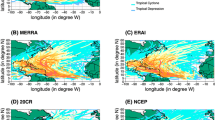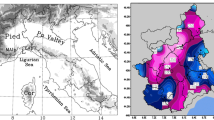Summary
Intensity forecasts of a hurricane are shown to be quite sensitive to the initial meso-convective scale precipitation distributions. These are included within the data assimilation using a physical initialization that was developed at Florida State University. We show a case study of a hurricane forecast where the inclusion of the ‘observed’ precipitation did provide reasonable intensity forecasts. Further experimentation with the inclusion or exclusion of individual meso-convective rainfall elements, around and over the storm, shows that the intensity forecasts were quite sensitive to these initial rainfall distributions. The exclusion of initial rain in the inner rain area of a hurricane leads to a much reduced intensity forecast, whereas that impact is less if the rainfall of an outer rain band was initially excluded.
Intensity forecasts of hurricanes may be sensitive to a number of factors such as sea surface temperature anomalies, presence or absence of concentric eye walls, potential vorticity interactions in the upper troposphere and other environmental factors.
This paper is a sequel to a recent study, Krishnamurti et al., 1997, on the prediction of hurricane OPAL of 1995 that was a category III storm over the Gulf of Mexico. In that study we showed successful forecasts of the storm intensity from the inclusion of observed rainfall distributions within physical initialization. In that paper we examined the issues of diabatic potential vorticity and the angular momentum in order to diagnose the storm intensity. All of the terms of the complete Ertel potential vorticity equation were evaluated and it was concluded that the diabatic contributions to the potential vorticity were quite important for the diagnosis of the storm's intensity. The present paper addresses some sensitivity issues related to the individual mesoconvective precipitating elements.
Similar content being viewed by others
References
Businger, J. A., Wyngard, J. C., Izumi, Y., Bradley, E. F., 1971: Flux profile relationship in the atmospheric surface layer.J. Atmos. Sci.,28, 181–189.
Gairola, R. K., Krishnamurti, T. N., 1992: Rain rates based on SSM/I, OLR and raingauge data sets.Meteorol. Atmos. Phys.,50, 165–174.
Harshvardan, Corsetti, T. G., 1984:Long-wave parameterization for the UCLA/GLAS GCM. NASA Tech. Memo 86072, Goddard Space Flight Center, Greenbelt, MD 20771, 52 pp.
Kanamitsu, M., Tada, K., Kudo, K., Sato, N., Isa, S., 1983: Description of the JMA operational spectral model.J. Meteor. Soc. Japan,61, 812–828.
Kanamitsu, M., 1975: On numerical prediction over a global tropical belt. Report No. 75-1, Dept. of Meteorology, Florida State University, Tallahassee, Florida 32306, pp. 1–282.
Kitade, T., 1983: Nonlinear normal mode initialization with physics.Mon. Wea. Rev.,111, 2194–2213.
Krishnamurti, T. N., Han, W., Jha, B., Bedi, H. S., 1997: Numerical prediction of hurricane Opal.Mon. Wea. Rev. (submitted).
Krishnamurti, T. N., Rohaly, G. D., Bedi, H. S., 1994: On the improvement of precipitation forecast skill from physical initialization.Tellus,46A, 598–614.
Krishnamurti, T. N., Bedi, H. S., Ingles, K., 1993: Physical initialization using SSM/I rain rates.Tellus,45A, 247–269.
Krishnamurti, T. N., Xue, J., Bedi H. S., Ingles, K., Oosterhof, D., 1991: Physical initialization for numerical weather prediction over the tropics.Tellus,43AB 53–81.
Krishnamurti, T. N., Low-Nam, S., Pasch, R., 1983: Cumulus parameterization and rainfall rates II:Mon. Wea. Rev.,111, 816–828.
Lacis, A. A., Hansen, J. E., 1974: A parameterization of the absorption of solar radiation in the earth's atmosphere.J. Atmos. Sci.,31, 118–133.
Louis, J. F., 1979: A parametric model of vertical eddy fluxes in the atmosphere.Bound.-Layer Meteor.,17, 187–202.
Molinari, J., Dickinson, M., Vollaro, D., Knight, D., Skubis, S., 1997: Potential vorticity, easterly waves and tropical cyclogenesis.Mon. Wea. Rev., (in press).
Tiedke, M., 1984: The sensitivity of the time-mean large-scale flow to cumulus convection in the ECMWF model.Workshop on convection in large-scale numerical models. ECMWF, 28 Nov.–1 Dec. 1983, 297–316.
Wallace, J. M., Tibaldi, S., Simmons, A. J., 1983: Reduction of systematic forecast errors in the ECMWF model through the introduction of envelope orography.Quart. J. Roy. Meteor. Soc.,109, 683–718.
Willoughby, H. E., 1988: The dynamics of the tropical cyclone core.Aust. Meteor. Mag.,36, 183–191.
Yanai, M., Esbensen, S., Chu, J. H., 1973: Determination of bulk properties of tropical cloud clusters from large-scale heat and moisture budgets.J. Atmos. Sci.,30, 611–627.
Author information
Authors and Affiliations
Additional information
With 4 Figures
Rights and permissions
About this article
Cite this article
Krishnamurti, T.N., Han, W. & Oosterhof, D. Sensitivity of hurricane intensity forecasts to physical initialization. Meteorl. Atmos. Phys. 65, 171–181 (1998). https://doi.org/10.1007/BF01030786
Received:
Revised:
Issue Date:
DOI: https://doi.org/10.1007/BF01030786




